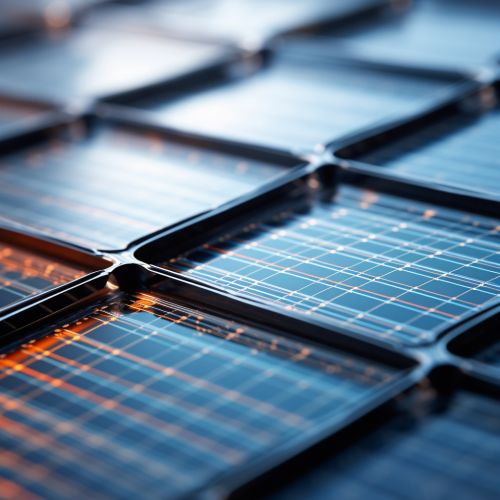The Physics of Solar Cells and Photovoltaic Efficiency
Introduction
Solar cells, also known as photovoltaic cells, are devices that convert light energy, usually from the sun, into electrical energy through the photovoltaic process. The efficiency of solar cells is a critical factor in the viability of solar power as a renewable energy source. This article delves into the physics of solar cells and the factors that affect their photovoltaic efficiency.
The Physics of Solar Cells
Solar cells operate based on the principles of quantum physics. When a photon of light strikes the surface of a solar cell, it can be absorbed by the cell's semiconductor material, typically silicon. This absorption of light energy can excite an electron from its ground state to an excited state, creating an electron-hole pair. The energy required to excite an electron to this state is known as the bandgap energy.


Absorption of Light and Generation of Electron-Hole Pairs
The absorption of light and the subsequent generation of electron-hole pairs is the first step in the photovoltaic process. The efficiency of this process is largely determined by the bandgap of the semiconductor material. The bandgap is the energy difference between the valence band, where electrons are normally present, and the conduction band, where they can move freely and contribute to electrical current.
Separation of Electron-Hole Pairs
Once an electron-hole pair is generated, they must be separated for the cell to produce an electric current. This separation is achieved through the built-in electric field of the solar cell, which is created by doping the semiconductor material to form a p-n junction.
Collection of Charge Carriers
The final step in the photovoltaic process is the collection of the separated charge carriers at the cell's electrodes. The efficiency of this process is influenced by the design of the cell's electrodes and the quality of the semiconductor material.
Photovoltaic Efficiency
Photovoltaic efficiency refers to the ratio of the electrical power output from a solar cell to the incident light power. It is a key parameter in evaluating the performance of solar cells. Several factors can affect the photovoltaic efficiency of a solar cell.
Bandgap Energy
The bandgap energy of the semiconductor material can significantly affect the cell's efficiency. If the bandgap is too low, many of the absorbed photons will have more energy than necessary to excite an electron, and the excess energy is lost as heat. If the bandgap is too high, many photons will not have enough energy to excite an electron, resulting in a lower current output.
Quantum Efficiency
Quantum efficiency refers to the number of electron-hole pairs generated per incident photon. It is affected by the absorption properties of the semiconductor material and the probability of generating an electron-hole pair.
Carrier Collection Efficiency
Carrier collection efficiency is the proportion of generated charge carriers that are collected at the electrodes. It is influenced by the design of the cell's electrodes and the quality of the semiconductor material.
Losses in Solar Cells
Various losses can occur in solar cells, reducing their photovoltaic efficiency. These include optical losses, such as reflection and transmission losses, and electrical losses, such as resistive losses and recombination losses.
Improving Photovoltaic Efficiency
There are several strategies for improving the photovoltaic efficiency of solar cells. These include optimizing the bandgap of the semiconductor material, improving the quality of the material to reduce recombination losses, and enhancing the design of the cell's electrodes to improve carrier collection efficiency.
Conclusion
The physics of solar cells and photovoltaic efficiency is a complex and fascinating field. Understanding these principles can help in the design and optimization of solar cells, contributing to the advancement of solar power as a viable and sustainable energy source.
